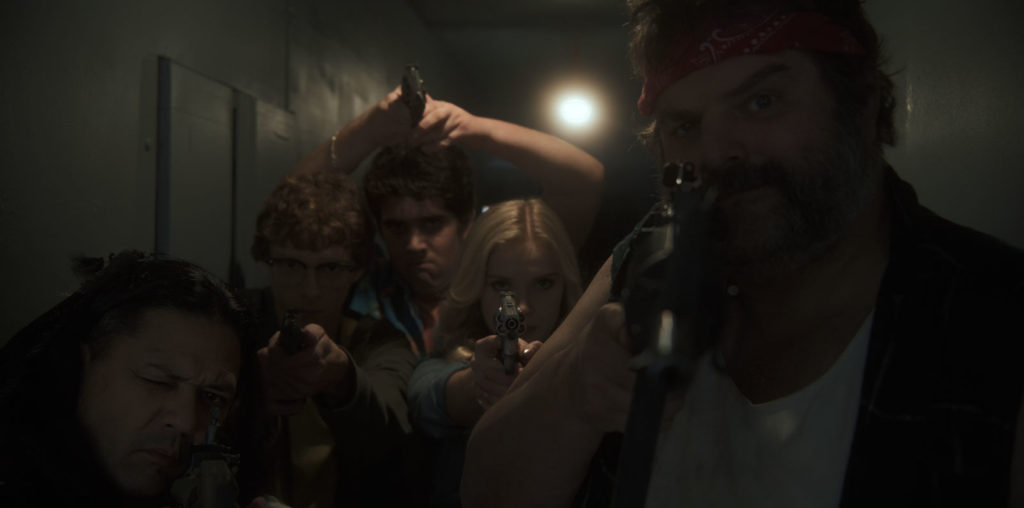
If you are an avid fan of “Friends,” you’ll know Larry Hankin as Mr. Heckles, the eccentric downstairs neighbor. “Seinfeld” viewers will remember him as “TV Kramer”. Not Pizarro Kramer, but the other one. As a participant in the presentation of someone else’s imagination, Larry Hankin proves to be an excellent actor, organically idiosyncratic and loony. As a player in his own ideas and fictions, though, Hankin demonstrates a natural talent for comedic storytelling in the tradition of a folklorist. “Larry Hankin: 10 funny fables” (2004), a collection of ten short films mostly written, produced, and directed by Hankin, offers audiences access to the artistic genius of its maker.
The first short, “The Last Tape” (2002), is a witty critique of the American government’s “inability” to locate and apprehend Osama Bin Laden. Larry Hankin gives a highly amusing rendition of a tall, lanky, Middle-Eastern man who by all circumstantial accounts should be Osama himself. The premise of this short involves the abduction of an American journalist (Howard Hesseman) who finds himself in what is likely to be an Al Qaeda lair. He meets Osama, who wishes to do an interview during which the camera is to be on him at all times or else someone’s hand or head will be removed. Question-and-answer topics cover areas such as anti-American sentiments, the role of women, Osama’s doubles, hobbies, and movies. Overtly, “The Last Tape” rubs salt in the wound of American intelligence incompetence, but at the same time, it feeds the fire of certain conspiracy theories suggesting that the government knows exactly where Osama is and everything there is to know about him (right down to undergarment preference and whether or not there are food allergies). Hankin’s portrayal of Osama is humanistic and funny to the point where we wouldn’t hold his bad deeds against him. A guy can’t be that bad if he knows to put on proper makeup and choose the right outfit before stepping in front of a camera.
In addition to putting an interesting spin onto a person(a) somewhat known to the general public, Larry Hankin creates fascinating characters almost representative of people we may encounter but are too hesitant to know. Such quirkiness and innovativeness surfaces in four of the ten fables: “My Uncle Emmett,” “The Lost Tapes of Emmett Sagittarius Deemus,” “The Magic Credit Card” (Dean Hollander), and “Frogs Never Lie.” Uncle Emmett (Hankin) is a character featured in “My Uncle Emmett” and “The Lost Tapes of Emmett Sagittarius Deemus”; he’s a philosophical fabulist who is fictional but only because the audience knows the wiser. With a mockumentary style aesthetic, Hankin introduces to the viewer a parking enforcement officer who got into an accident and forgot his identity. The man who emerges from the insane asylum is obsessed with borrowing motorcycles and telling stories. These tales would inspire the birth of Sometimes Jones, a sometimes illustrated character in “The Magic Credit Card,” a clever allegory on cheating and stealing. The mention of Sometimes Jones is accompanied by Uncle Emmett’s assertion that his nephew took ideas and didn’t credit their original source (*cough* Uncle Emmett). To exhibit his storytelling skills, Uncle Emmett entertains the cameraman with a fable called “Frogs Never Lie,” at which point the short “Frogs Never Lie” starts. A sprinkling of “The Frog Prince” by the Brothers Grimm combined with an interpretation of a hitch-hiker’s dilemma constitutes the narrative of the short.
“The Independent” (Stephen Kessler) is one of three shorts that Hankin did not direct (the other two being “The Magic Credit Card” and a two-minute spoken word piece entitled “I Hate to Say I Told You So” directed by Dean Hollander). Jerry Stiller is the title character in this ten-minute long short about how to buy rights to make a movie. Janeane Garofolo and Max Perlich take turns as the Independent’s assistant; Hankin plays William, an institutionalized killer who is negotiating a deal to turn his biography into a movie. Wrapped in a straight-jacket and wheeled into the room on a stretcher contraption, William and the Independent chat about splitting profits to singing verses from Broadway musicals. It all ends with a bang that you won’t see coming. Speaking of an unexpected transpiration of events, the “I Hate to Say I Told You So” short begins quickly and surreptitiously—embedded in the segment of the sequence that includes four Sometimes Jones sketches—and showcases Hankin in a “standup comic” role. The setting is reprised in “The Quicksand Hero,” which is footage from an actual performance at the Checca Club in Hollywood. Hankin is a comedian whose jokes don’t merely describe the trivialities of everyday life. His humor is molded into the oral tradition, simultaneously inciting laughter and communicating a moral-of-the story like an acerbic Aesop.
Hankin’s fables favor underdogs and unusual situations that provide an ostensibly novel setting for the encouragement of smart thinking, which is the message in the Academy Award nominated short “Solly’s Diner” (1979). A homeless man (Hankin), a businessman (Roger Bowen), a drunk (Paul Willson), and a waitress (Ruth Silvera) share a few tense moments in a diner in the late, late hours of the evening. Both the homeless man and the businessman want something from the waitress, but only one of them is going to be successful. The final short is “Revenge of the Ring Thing,” which is less of a parody and more of a what-you-didn’t-know-about-Gandalf sketch. Hankin plays Gandalf’s younger brother Randalf, a semi-incompetent member of his wizard family. “Revenge of the Ring” finds him studying to take his wizard’s exam for the 100th and some odd time. While Randalf is conversing with his puppet friend Spanky as well as the camera about Gandalf’s tendency to bully and that Gondor is a very hot place that doesn’t have air conditioning, an evil prophecy is set to be fulfilled. If it stays on course, a warrior princess (Genevieve Mishlen) will take Gandalf’s sacred silver sword of truth and kill Randalf. Lasting fifteen minutes in length, “Revenge of the Ring” nicely wraps up the sampling of Larry Hankin’s humor, creativity, and gift for telling slightly odd but fully heartwarming stories.

